| Achimenes
The genus Achimenes, belongs to the family Gesneriaceae. Its common name is Magic flowers. These are low growing fleshy herb with showy tubular flowers at tips of shoots. They prefer part shade and humidity, good in hanging baskets. Propagate by division of rhizomes....(Excerpt from page) Click to read more
|
Agapanthus Growing
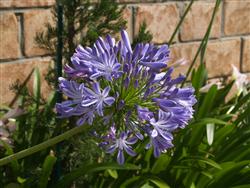 Agapanthus belong to the family Amaryllidaceae. They have green strap-like leaves, heads of white or blue flowers on stalks above foliage. Old forms display flowers 1m above plant. New forms available as dwarfs. Agapanthus are hardy and drtought tolerant once established; being widely cultivated around the world from temerate to tropical areas....(Excerpt from page) Click to read more Agapanthus belong to the family Amaryllidaceae. They have green strap-like leaves, heads of white or blue flowers on stalks above foliage. Old forms display flowers 1m above plant. New forms available as dwarfs. Agapanthus are hardy and drtought tolerant once established; being widely cultivated around the world from temerate to tropical areas....(Excerpt from page) Click to read more
|
Allamanda Cultivation
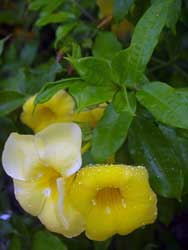 Genus: Allamanda
Common Name: Allamanda
Family: Apocynaceae
Appearance: Sprawling shrubs or climbers with highly coloured flowers. Large seed capsules usually with a thorny shell. All parts of the plant considered poisonous, although some native medicines use them as a laxative and colic treatment when administered in light doses.
Flowers: Commonly yellow trumpets, but hybridising has resulted in new colours. Long flowering period.
Features: Brightly coloured plant used in tropical landscapes as small hedging plants. Some have been used successfully as a bonsai specimen.
Requirements: Prefers moist fertile well-drained soils. Adapted to clays and sandy types. Regular watering and fertilising will encourage growth and flowers. Excessive nitrogen fertilisers may r...(Excerpt from page) Click to read more
Genus: Allamanda
Common Name: Allamanda
Family: Apocynaceae
Appearance: Sprawling shrubs or climbers with highly coloured flowers. Large seed capsules usually with a thorny shell. All parts of the plant considered poisonous, although some native medicines use them as a laxative and colic treatment when administered in light doses.
Flowers: Commonly yellow trumpets, but hybridising has resulted in new colours. Long flowering period.
Features: Brightly coloured plant used in tropical landscapes as small hedging plants. Some have been used successfully as a bonsai specimen.
Requirements: Prefers moist fertile well-drained soils. Adapted to clays and sandy types. Regular watering and fertilising will encourage growth and flowers. Excessive nitrogen fertilisers may r...(Excerpt from page) Click to read more
|
Alocasia
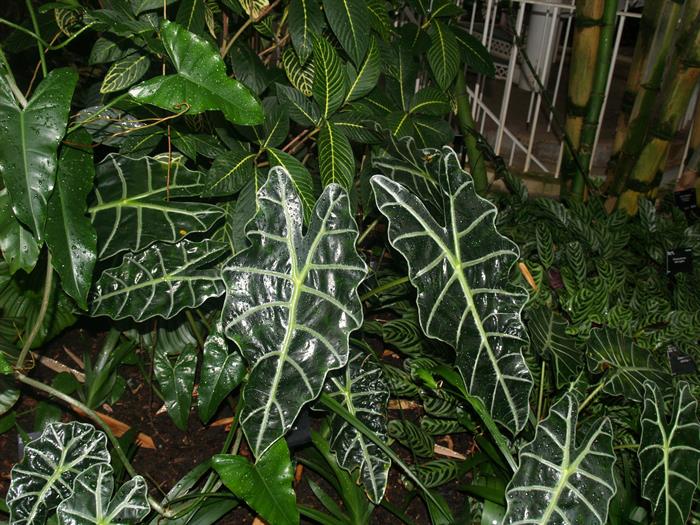 ...(Excerpt from page) Click to read more ...(Excerpt from page) Click to read more
|
Alpinia (Ginger)
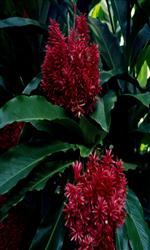 GINGER
Genus Alpinia
Family Zingiberaceae
Common Name Gingers
Appearance
Fleshy pseudostems arising from underground rhizomes. Pseudostems display alternating leaf blades. Small flowers are borne in clusters of bracts either close at ground level or at the tips of pseudostems.
Establishment
Apply plenty of peat of compost to the site. Additional fertiliser beneficial. Provide protection from wind and full sun in early stages. Select a protected moist site and humidity. In low humidity areas, select a dappled light site and water the foliage. Avoid frosts. Propagate by division of rhizomes
Culture
Keep moist to encourage vigorous growth and long flowering period, Responds well to mulching, Few pests (occasionally grasshoppers) and diseases
...(Excerpt from page) Click to read more GINGER
Genus Alpinia
Family Zingiberaceae
Common Name Gingers
Appearance
Fleshy pseudostems arising from underground rhizomes. Pseudostems display alternating leaf blades. Small flowers are borne in clusters of bracts either close at ground level or at the tips of pseudostems.
Establishment
Apply plenty of peat of compost to the site. Additional fertiliser beneficial. Provide protection from wind and full sun in early stages. Select a protected moist site and humidity. In low humidity areas, select a dappled light site and water the foliage. Avoid frosts. Propagate by division of rhizomes
Culture
Keep moist to encourage vigorous growth and long flowering period, Responds well to mulching, Few pests (occasionally grasshoppers) and diseases
...(Excerpt from page) Click to read more
|
Ardisia
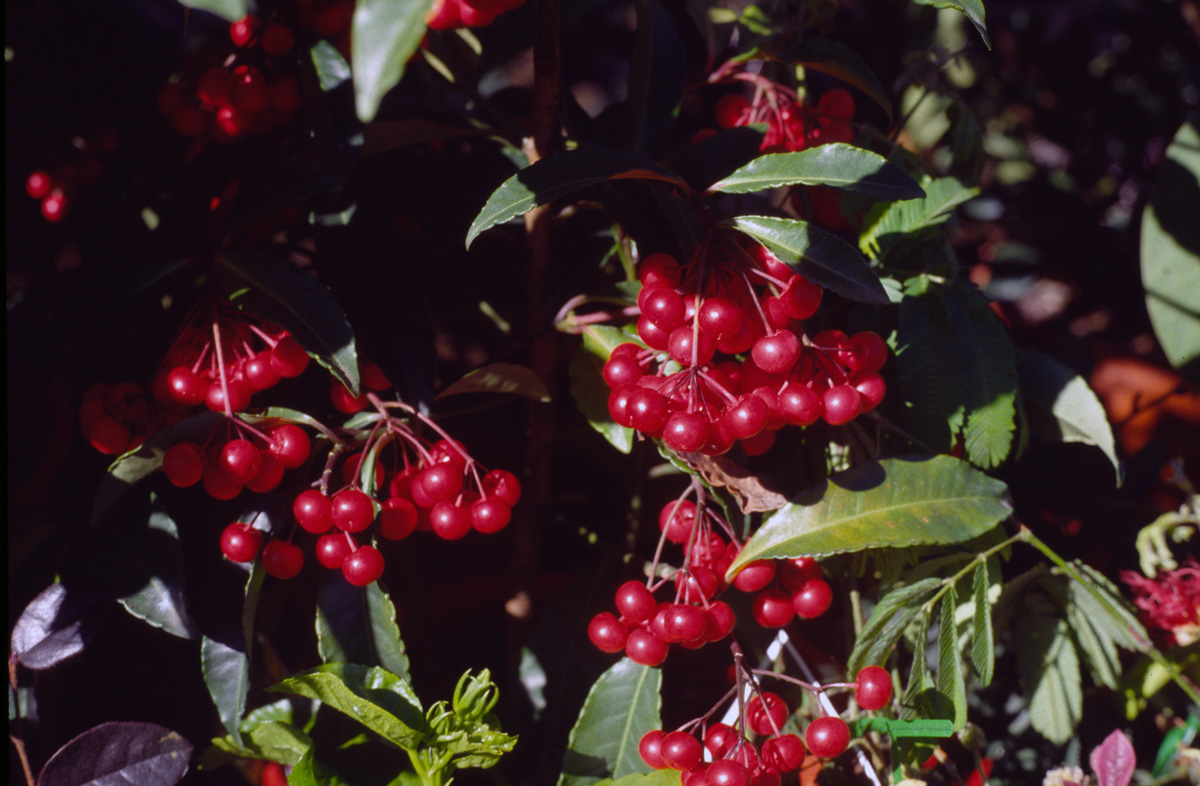 Genus: Ardisia
Common Name : Coral Berry
Family: Myrsinaceae
Appearance: Mostly evergreen shrubs or trees with leathery, dark green and glossy leaves. Flowers: Small either white or pink to rose coloured.
Features: Decorative plants due to their attractive berries.
Requirements: Prefers moist cool soil, but will handle drier conditions if provided with shade. Provide part shade or full sun.
Culture: Apply general fertiliser four times a year. Foliar fertiliser application is beneficial for growth.
Pruning will encourage bushier habit. Mulch to keep roots cool and moist. Most propagates easily by seed or cuttings.
...(Excerpt from page) Click to read more
Genus: Ardisia
Common Name : Coral Berry
Family: Myrsinaceae
Appearance: Mostly evergreen shrubs or trees with leathery, dark green and glossy leaves. Flowers: Small either white or pink to rose coloured.
Features: Decorative plants due to their attractive berries.
Requirements: Prefers moist cool soil, but will handle drier conditions if provided with shade. Provide part shade or full sun.
Culture: Apply general fertiliser four times a year. Foliar fertiliser application is beneficial for growth.
Pruning will encourage bushier habit. Mulch to keep roots cool and moist. Most propagates easily by seed or cuttings.
...(Excerpt from page) Click to read more
|
Aucuba
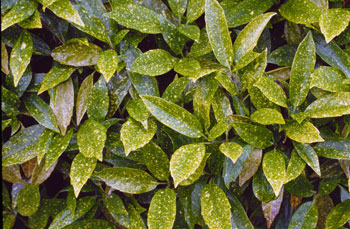 Genus: Aucuba
Family: Cornaceae
Appearance: Rounded evergreen shrubs, simple leaves, entire to dentate; fruits are a berry-like drupe.
Flowers: Purple flowers in panicles.
Features: Grown for their ornamental foliage and colourful berries.
Origin: 3 or 4 species; from Himalayas to East Asia and Japan.
...(Excerpt from page) Click to read more
Genus: Aucuba
Family: Cornaceae
Appearance: Rounded evergreen shrubs, simple leaves, entire to dentate; fruits are a berry-like drupe.
Flowers: Purple flowers in panicles.
Features: Grown for their ornamental foliage and colourful berries.
Origin: 3 or 4 species; from Himalayas to East Asia and Japan.
...(Excerpt from page) Click to read more
|
Azaleas
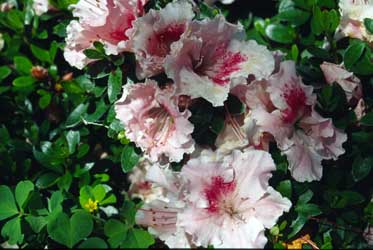 Azalea
Family Ericaceae
These are actually in the genus Rhododendron (refer to Rhododendron) though they are generally treated separately. They are smaller growing shrubs than other rhododendrons, with both smaller leaves, and generally a lesser height. (see classification below).
The Indicas and Kurumes are adaptable shrubs and have a wide variety of uses, including (depending on variety). Mollis azaleas are less hardy and do not do well in milder climates.
...(Excerpt from page) Click to read more
Azalea
Family Ericaceae
These are actually in the genus Rhododendron (refer to Rhododendron) though they are generally treated separately. They are smaller growing shrubs than other rhododendrons, with both smaller leaves, and generally a lesser height. (see classification below).
The Indicas and Kurumes are adaptable shrubs and have a wide variety of uses, including (depending on variety). Mollis azaleas are less hardy and do not do well in milder climates.
...(Excerpt from page) Click to read more
|
| Azaleas & Rhodos
RHODODENDRONS AND AZALEAS
Rhododendrons and azaleas are amongst our best-loved garden plants. Each spring, these popular shrubs put on a spectacular long-lasting display of colourful flowers. Although they’re most commonly seen in cool climate and temperate gardens, choose the right varieties and you can grow them in warm, humid climates as well. There are rhododendrons that occur naturally in the snow-covered Himalayas, and others from tropical south east Asia; there is even one that is native to the tropical rainforests of Australia.
...(Excerpt from page) Click to read more
|
Bamboos for the Garden
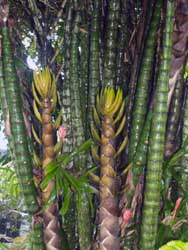 Bamboos grow well in most parts of the world, and can be appropriate to gardens almost anywhere provided you select an appropriate variety to suite the climate and situation it is used in; then treat it according to that situation.
Bamboo poles have also been used as construction material in gardens (and elswhere) for centuries.
Stands of bamboos can provide an Asian feel of theme to the garden, whether small or large varieties are used.
...(Excerpt from page) Click to read more Bamboos grow well in most parts of the world, and can be appropriate to gardens almost anywhere provided you select an appropriate variety to suite the climate and situation it is used in; then treat it according to that situation.
Bamboo poles have also been used as construction material in gardens (and elswhere) for centuries.
Stands of bamboos can provide an Asian feel of theme to the garden, whether small or large varieties are used.
...(Excerpt from page) Click to read more
|
Barleria
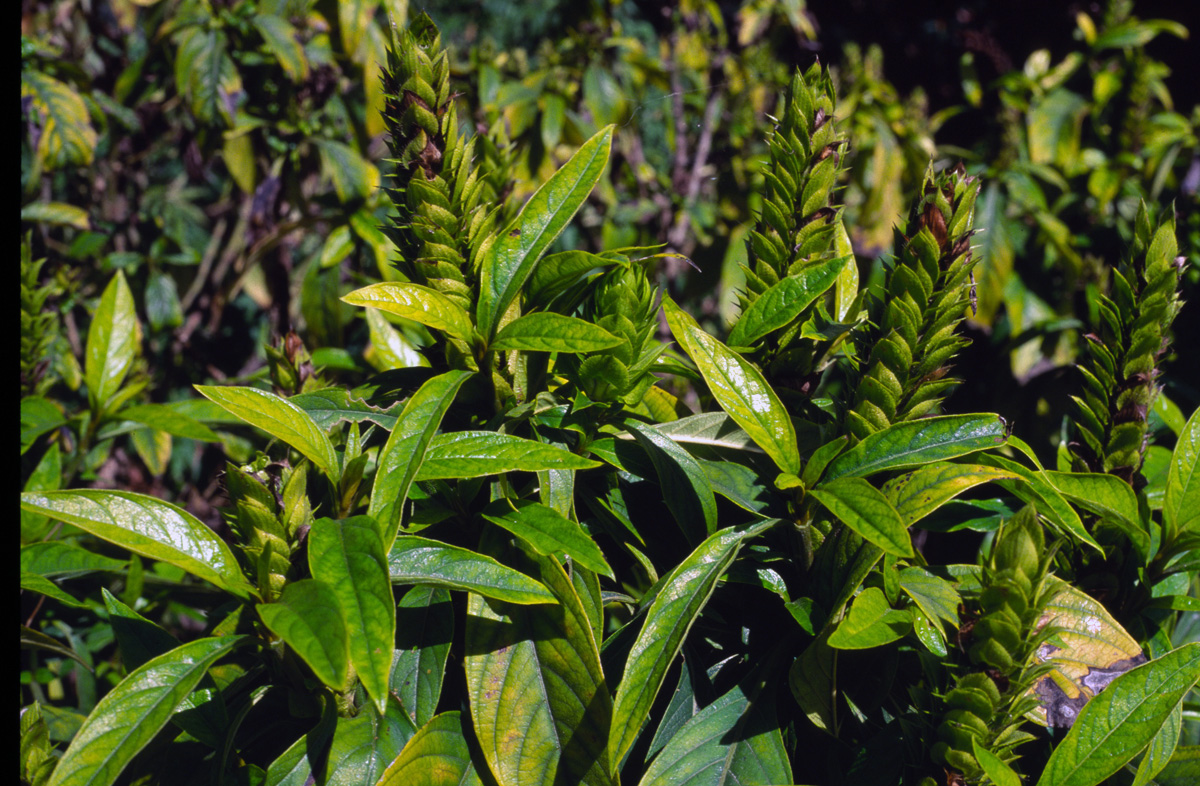 Genus: Barleria
Common Name: Philippine violet
Family: Acanthaceae
Appearance: -Small shrubs & herbs. Dark green leaves on sprawling shrub.
Flowers: Blue or white, spot flowering for most of the year.
Features: Attractive small hedging plant with spot flowers.
...(Excerpt from page) Click to read more
Genus: Barleria
Common Name: Philippine violet
Family: Acanthaceae
Appearance: -Small shrubs & herbs. Dark green leaves on sprawling shrub.
Flowers: Blue or white, spot flowering for most of the year.
Features: Attractive small hedging plant with spot flowers.
...(Excerpt from page) Click to read more
|
Bauhinia
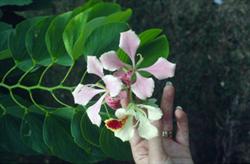 Genus: Bauhinia
Common Name: Butterfly shrub
Family: Caesalpinaceae
Appearance: Trees, woody shrubs, climbers and groundcovers, deep green lobed leaves which usually close at night time.
Flowers: Pink, orange, red flowers for long periods in spring and summer.
Features: Good plants for landscape use and low maintenance gardens. Some may carry thorns.
Requirements: Moist fertile soils referred. Will handle occasional dry periods. Known to grow well on impoverished soil. Tolerant of a wide range of variables in light, wind, etc.
...(Excerpt from page) Click to read more
Genus: Bauhinia
Common Name: Butterfly shrub
Family: Caesalpinaceae
Appearance: Trees, woody shrubs, climbers and groundcovers, deep green lobed leaves which usually close at night time.
Flowers: Pink, orange, red flowers for long periods in spring and summer.
Features: Good plants for landscape use and low maintenance gardens. Some may carry thorns.
Requirements: Moist fertile soils referred. Will handle occasional dry periods. Known to grow well on impoverished soil. Tolerant of a wide range of variables in light, wind, etc.
...(Excerpt from page) Click to read more
|
Breynia
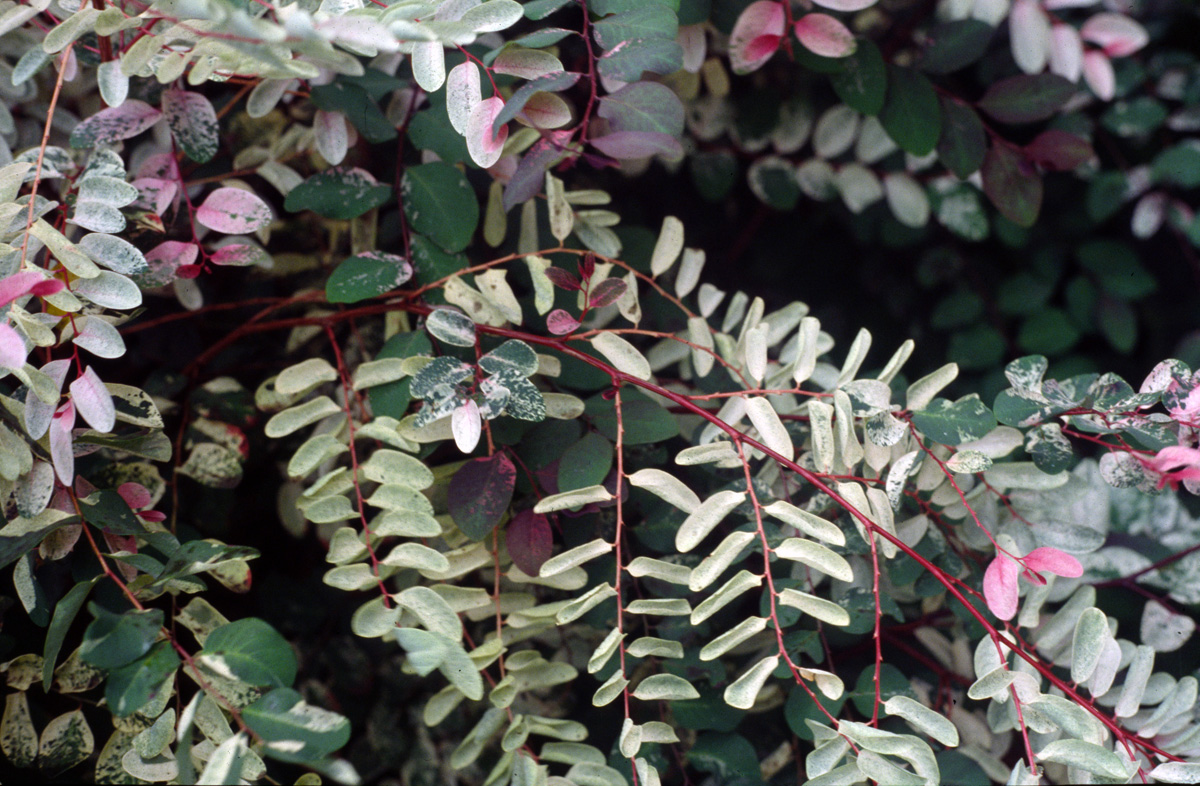 Genus: Breynia
Common Name: Snow bush
Family: Euphorbiaceae
Appearance: Semi-weeping bushy medium shrub with coloured foliage.
Flowers: Small insignificant flowers.
Features: Highly decorative plant in landscapes, berries attract birds.
Requirements: Well drained moist soils required. Mostly tropical and subtropical plants adaptable to various sites except strong sea breezes.
...(Excerpt from page) Click to read more
Genus: Breynia
Common Name: Snow bush
Family: Euphorbiaceae
Appearance: Semi-weeping bushy medium shrub with coloured foliage.
Flowers: Small insignificant flowers.
Features: Highly decorative plant in landscapes, berries attract birds.
Requirements: Well drained moist soils required. Mostly tropical and subtropical plants adaptable to various sites except strong sea breezes.
...(Excerpt from page) Click to read more
|
Brugmansia
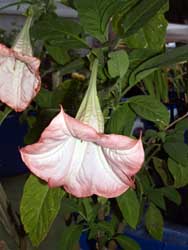 Genus: Brugmansia
Common Name: Angels Trumpet
Family: Solanaceae
Appearance: Shrubs or small trees with large green leaves usually of umbrella shape.
Flowers: Drooping trumpet (cone) shaped large flowers, between 15 and 50 cm long. Variable in colour and form.
Features: Most species scented at night, some varieties have narcotic properties (and can be poisonous). Visually attractive when grown as an untrimmed hedge.
Requirements: requires well drained fertile soils. Branches are brittle and break in the wind. Mostly tropical and subtropical plants sensitive to frost.
...(Excerpt from page) Click to read more
Genus: Brugmansia
Common Name: Angels Trumpet
Family: Solanaceae
Appearance: Shrubs or small trees with large green leaves usually of umbrella shape.
Flowers: Drooping trumpet (cone) shaped large flowers, between 15 and 50 cm long. Variable in colour and form.
Features: Most species scented at night, some varieties have narcotic properties (and can be poisonous). Visually attractive when grown as an untrimmed hedge.
Requirements: requires well drained fertile soils. Branches are brittle and break in the wind. Mostly tropical and subtropical plants sensitive to frost.
...(Excerpt from page) Click to read more
|
Brunfelsia
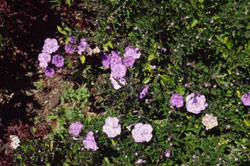 Genus: Brunfelsia
Common Name: Yesterday, Today and Tomorrow
Family: Solanaceae
Appearance: Bushy shrubs or small trees with light to deep green leaves.
Flowers: Tubular scented flowers mostly in spring.
Features: Ornamental hedging plants with colourful scented flowers. Good specimen plants.
...(Excerpt from page) Click to read more
Genus: Brunfelsia
Common Name: Yesterday, Today and Tomorrow
Family: Solanaceae
Appearance: Bushy shrubs or small trees with light to deep green leaves.
Flowers: Tubular scented flowers mostly in spring.
Features: Ornamental hedging plants with colourful scented flowers. Good specimen plants.
...(Excerpt from page) Click to read more
|
Buddleia
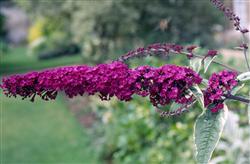 Genus: Buddleia
Common Name: Butterfly Bush
Family: Loganiaceae
Flowers: In heads, panicles or spikes (some very attractive). Mostly occurring in spring or summer.
Origin: Asia, Africa and Americas; around 100 species.
Appearance: Mostly evergreen shrubs, lanceolate leaves mostly opposite except in B. alternifolia, flowers are in heads as spikes or panicles.
Culture: Well-drained fertile soil, lime-tolerant; thrive in full sun, easy to grow. Prune long stems to stop them becoming straggly. Half-hardy species should be grown against a wall or in a greenhouse, or outdoors in mild temperate regions.
...(Excerpt from page) Click to read more
Genus: Buddleia
Common Name: Butterfly Bush
Family: Loganiaceae
Flowers: In heads, panicles or spikes (some very attractive). Mostly occurring in spring or summer.
Origin: Asia, Africa and Americas; around 100 species.
Appearance: Mostly evergreen shrubs, lanceolate leaves mostly opposite except in B. alternifolia, flowers are in heads as spikes or panicles.
Culture: Well-drained fertile soil, lime-tolerant; thrive in full sun, easy to grow. Prune long stems to stop them becoming straggly. Half-hardy species should be grown against a wall or in a greenhouse, or outdoors in mild temperate regions.
...(Excerpt from page) Click to read more
|
Buxus
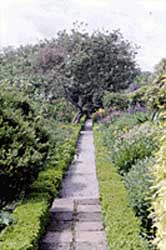 Buxus (Box)
...(Excerpt from page) Click to read more
Buxus (Box)
...(Excerpt from page) Click to read more
|
Caesalpinia
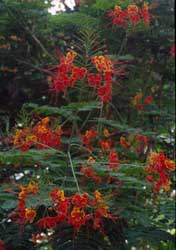 Genus: Caesalpinia
Common Name: Dwarf Poinciana
Family: Caesalpinaceae
Appearance: Small to large lanky shrubs partially deciduous plants. Foliage is pinnate.
Flowers: Highly attractive, orange or yellow tones borne in clusters over long periods, which are followed by brown or black pods.
Features: Grown as a specimen plant or informal hedge.
Requirements: Adapted to most well drained soil types. Tropical to warm temperate is tolerated by most species. Not for sea coast planting.
...(Excerpt from page) Click to read more
Genus: Caesalpinia
Common Name: Dwarf Poinciana
Family: Caesalpinaceae
Appearance: Small to large lanky shrubs partially deciduous plants. Foliage is pinnate.
Flowers: Highly attractive, orange or yellow tones borne in clusters over long periods, which are followed by brown or black pods.
Features: Grown as a specimen plant or informal hedge.
Requirements: Adapted to most well drained soil types. Tropical to warm temperate is tolerated by most species. Not for sea coast planting.
...(Excerpt from page) Click to read more
|
Calliandra
 Genus: Calliandra
Common Name: Powder Puff
Family: Mimosaceae
Appearance: Woody ground covers, shrubs & trees usually slow in growth. Pinnate deep green leaves and showy puffy flowers borne at the ends of branches.
Flowers: Bright red or white pom-pom like flowers throughout the year.
Features: Attracts some species of birds. Attractive informal hedging plant.
Requirements: Very adaptable to dry and moist soils. Well watered, well drained and well fertilised soils preferred. Not tolerant of sea breezes. Full sun or partial shade.
...(Excerpt from page) Click to read more
Genus: Calliandra
Common Name: Powder Puff
Family: Mimosaceae
Appearance: Woody ground covers, shrubs & trees usually slow in growth. Pinnate deep green leaves and showy puffy flowers borne at the ends of branches.
Flowers: Bright red or white pom-pom like flowers throughout the year.
Features: Attracts some species of birds. Attractive informal hedging plant.
Requirements: Very adaptable to dry and moist soils. Well watered, well drained and well fertilised soils preferred. Not tolerant of sea breezes. Full sun or partial shade.
...(Excerpt from page) Click to read more
|
Callicarpa
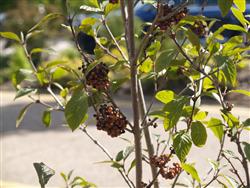 Genus: Callicarpa
Common Name: Beauty Berry
Family: Verbenaceae
Appearance: Spreading arching shrub with attractive berries usually borne over winter, some can become sparse and straggly without pruning.
Flowers: Insignificant flower clusters precede attractive pink, lavender or white berries.
Features: Graceful looking plant with colourful berries. Used in floristry.
Requirements: Requires rich, well drained moist soils. Good ventilation, full or filtered sun, for most avoid shade. Not for hot dry locations. Tolerates wind very well.
...(Excerpt from page) Click to read more
Genus: Callicarpa
Common Name: Beauty Berry
Family: Verbenaceae
Appearance: Spreading arching shrub with attractive berries usually borne over winter, some can become sparse and straggly without pruning.
Flowers: Insignificant flower clusters precede attractive pink, lavender or white berries.
Features: Graceful looking plant with colourful berries. Used in floristry.
Requirements: Requires rich, well drained moist soils. Good ventilation, full or filtered sun, for most avoid shade. Not for hot dry locations. Tolerates wind very well.
...(Excerpt from page) Click to read more
|
Camellias
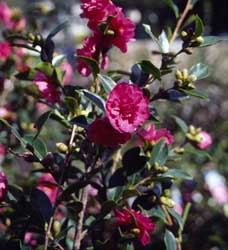 Camellia
Family Theaceae
Approximately 80 species; and thousands of named cultivars.
Used as an ornamental shrubbery plant, a topiary, hedge, or tub plant. They will grow surrounded by lawn or paving; and can even be espaliered. Both C. sasanqua and C. japonica can be trained as a hedge. C. sinensis, the source of commercial tea, can be grown in tropical areas as a crop, or as an ornamental.
Camellias are mainly evergreen shrubs (some small trees); leaves simple, toothed margins, alternate, thick, leathery and usually with showy flowers.
...(Excerpt from page) Click to read more
Camellia
Family Theaceae
Approximately 80 species; and thousands of named cultivars.
Used as an ornamental shrubbery plant, a topiary, hedge, or tub plant. They will grow surrounded by lawn or paving; and can even be espaliered. Both C. sasanqua and C. japonica can be trained as a hedge. C. sinensis, the source of commercial tea, can be grown in tropical areas as a crop, or as an ornamental.
Camellias are mainly evergreen shrubs (some small trees); leaves simple, toothed margins, alternate, thick, leathery and usually with showy flowers.
...(Excerpt from page) Click to read more
|
Cassia or Senna
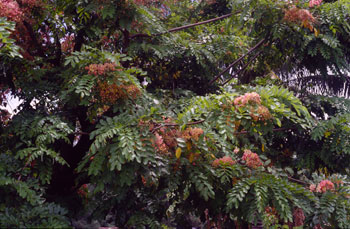 Genus: Cassia
Family: Caesalpinaceae
Appearance: Mainly shrubs to small trees, pinnate foliage with brittle branches.
Flowers: Yellow terminal clusters, often during warmer months.
Features: Birds attracting plants.
Requirements: Tolerates a wide range of soil types. Some species are sensitive to frosts. Full sun.
...(Excerpt from page) Click to read more
Genus: Cassia
Family: Caesalpinaceae
Appearance: Mainly shrubs to small trees, pinnate foliage with brittle branches.
Flowers: Yellow terminal clusters, often during warmer months.
Features: Birds attracting plants.
Requirements: Tolerates a wide range of soil types. Some species are sensitive to frosts. Full sun.
...(Excerpt from page) Click to read more
|
Cestrum
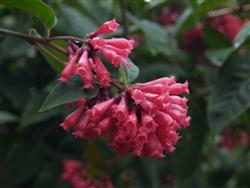 Genus: Cestrum
Family: Solanaceae
Appearance: Shrubs with light green foliage plants usually with terminal clusters of flowers.
Flowers: In terminal clusters of a long flowering period in spring and summer.
Features: Scent. Good background landscaping plant.
...(Excerpt from page) Click to read more
Genus: Cestrum
Family: Solanaceae
Appearance: Shrubs with light green foliage plants usually with terminal clusters of flowers.
Flowers: In terminal clusters of a long flowering period in spring and summer.
Features: Scent. Good background landscaping plant.
...(Excerpt from page) Click to read more
|
| Clerodendrum
Genus:
Clerodendrum
Common Name: Glory Bower or Tube Flower
Family: Verbenaceae
Appearance: Deciduous & evergreen shrubs and trees with attractive foliage and flowers.
Flowers: Stunning flowers of various colours produced over many months of the year. Features: Attractive plants for informal hedges and specimen plants.
Requirements: Fertile well drained moist soils preferred. Very adaptable to a range of sites except salt conditions. Bloom well in full sun of part shade. Will not tolerate drought.
...(Excerpt from page) Click to read more
|
Codiaeum, Croton
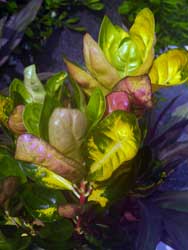 CROTON
Genus: Codiaeum
Common Name: Croton
Family: Euphorbiaceae
Appearance: Shrubs with highly coloured plants with upright woody stems.
Flowers: Insignificant flowers borne in summer.
Features: Coloured foliage, good for hedging. Slow growing.
Requirements: Moist fertile soil required. Prefers full sun and warm climates. Tolerates light sea breezes. Will not tolerate drought.
...(Excerpt from page) Click to read more
CROTON
Genus: Codiaeum
Common Name: Croton
Family: Euphorbiaceae
Appearance: Shrubs with highly coloured plants with upright woody stems.
Flowers: Insignificant flowers borne in summer.
Features: Coloured foliage, good for hedging. Slow growing.
Requirements: Moist fertile soil required. Prefers full sun and warm climates. Tolerates light sea breezes. Will not tolerate drought.
...(Excerpt from page) Click to read more
|
Conifers
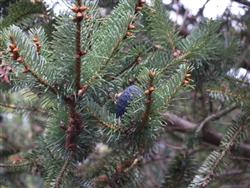 Think of traditional European or North American gardens and many people will think of conifers. These adaptable plants can provide a real contrast to many of the plants we commonly grow in Australia. In fact, there are several attractive species native to Australia, including the Norfolk Island Pine (Araucaria heterophylla), the Port Jackson Pine (Callitris rhomboidea) and the Queensland Kauri (Agathis robusta)....(Excerpt from page) Click to read more Think of traditional European or North American gardens and many people will think of conifers. These adaptable plants can provide a real contrast to many of the plants we commonly grow in Australia. In fact, there are several attractive species native to Australia, including the Norfolk Island Pine (Araucaria heterophylla), the Port Jackson Pine (Callitris rhomboidea) and the Queensland Kauri (Agathis robusta)....(Excerpt from page) Click to read more
|
Cordylines -How to grow codylines
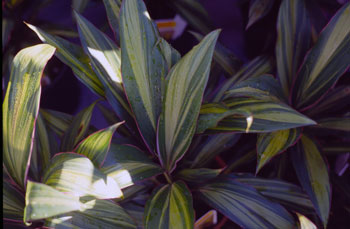 Cordyline is a genus in the Agavaceae family. Somethimes also known as Ti Plant, these have a shrub-like growth, with erect woody stemmed plant with strap like coloured foliage....(Excerpt from page) Click to read more Cordyline is a genus in the Agavaceae family. Somethimes also known as Ti Plant, these have a shrub-like growth, with erect woody stemmed plant with strap like coloured foliage....(Excerpt from page) Click to read more
|
Cornus -Dogwood
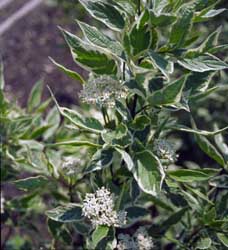 Cornus
Dogwood
Family Cornaceae
Approximately 45 species of mainly deciduous, with a few evergreen, small trees with simple, opposite, entire foliage – some may have brilliant autumn foliage.
Clusters of small flowers are accompanied with very showy white, pink or reddish bracts, mainly in spring, and sometimes followed by bright, attractive fruits (summer to autumn).
Generally hardy, with most suiting cool temperate to temperate climates. They are best in cool moist areas, although some occur in areas with hot/dry autumns.
Many need a warm autumn to give good early winter foliage colour and good spring flowers. All transplant easily, even as large plants. Protect from hot dry winds, and keep well watered during hot dry periods.
...(Excerpt from page) Click to read more
Cornus
Dogwood
Family Cornaceae
Approximately 45 species of mainly deciduous, with a few evergreen, small trees with simple, opposite, entire foliage – some may have brilliant autumn foliage.
Clusters of small flowers are accompanied with very showy white, pink or reddish bracts, mainly in spring, and sometimes followed by bright, attractive fruits (summer to autumn).
Generally hardy, with most suiting cool temperate to temperate climates. They are best in cool moist areas, although some occur in areas with hot/dry autumns.
Many need a warm autumn to give good early winter foliage colour and good spring flowers. All transplant easily, even as large plants. Protect from hot dry winds, and keep well watered during hot dry periods.
...(Excerpt from page) Click to read more
|
| Crucifix Orchids
Epidendrums can be grown in well drained garden beds or pots. They need plenty of organic matter to grow well, and are heavier feeders than many other orchids, responding well to almost any quantity of "well rotted" manure. Many propagate easily from stem cuttings and cuttings of side shoots, while some produce pseudobulbs and can be propagated by division....(Excerpt from page) Click to read more
|
Cuphea
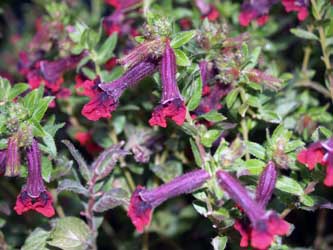 CIGAR PLANT
Genus: Cuphea
Common Name: Cigar Flower
Family: Lythraceae
Appearance: Small shrubs with small foliage and small but attractive flowers.
Flowers: Red, white or mauve flowers, usually tubular, over many months.
Features: Good for small hedges and pot specimens.
...(Excerpt from page) Click to read more
CIGAR PLANT
Genus: Cuphea
Common Name: Cigar Flower
Family: Lythraceae
Appearance: Small shrubs with small foliage and small but attractive flowers.
Flowers: Red, white or mauve flowers, usually tubular, over many months.
Features: Good for small hedges and pot specimens.
...(Excerpt from page) Click to read more
|
Cymbidium Orchids
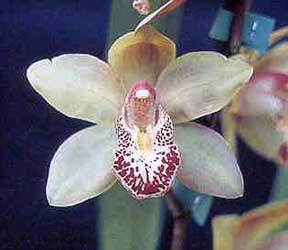 CYMBIDIUM (Abbreviation - Cym.)
There are approximately 50 species native to tropical Asia and Australia.
Most are terrestrial, but some are epiphytes.
Cymbidiums produce pseudobulbs, which can be large or in some cases very small; even insignificant. Each pseudobulb of a healthy plant will have many leaves under good conditions.
These leaves are normally long narrow and thick, but can sometimes vary.
The plants grow continuously, without a quiescent period that is typical of other orchids.
Appearing on lateral racemes, the flowers of this plant have petals and sepals that are similar and a lip that varies from entire to 3 lobed.
The Cymbidium genus is a very diverse group, with an immense number of hybrids and varieties.
Some Cymbidiums are mo...(Excerpt from page) Click to read more
CYMBIDIUM (Abbreviation - Cym.)
There are approximately 50 species native to tropical Asia and Australia.
Most are terrestrial, but some are epiphytes.
Cymbidiums produce pseudobulbs, which can be large or in some cases very small; even insignificant. Each pseudobulb of a healthy plant will have many leaves under good conditions.
These leaves are normally long narrow and thick, but can sometimes vary.
The plants grow continuously, without a quiescent period that is typical of other orchids.
Appearing on lateral racemes, the flowers of this plant have petals and sepals that are similar and a lip that varies from entire to 3 lobed.
The Cymbidium genus is a very diverse group, with an immense number of hybrids and varieties.
Some Cymbidiums are mo...(Excerpt from page) Click to read more
|
Daphne
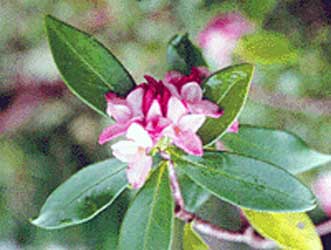 Daphne
Garland Flower
Family Thymelaeaceae
Around 50 species, and some hybrids, grown amongst other shrubs, as a tub specimen, or for cut flowers (scented).
Evergreen or deciduous shrubs, heads of very fragrant coloured flowers; leaves are simple and entire (not divided).
A large very large fleshy or leathery fruit occasionally occurs on plants.
...(Excerpt from page) Click to read more
Daphne
Garland Flower
Family Thymelaeaceae
Around 50 species, and some hybrids, grown amongst other shrubs, as a tub specimen, or for cut flowers (scented).
Evergreen or deciduous shrubs, heads of very fragrant coloured flowers; leaves are simple and entire (not divided).
A large very large fleshy or leathery fruit occasionally occurs on plants.
...(Excerpt from page) Click to read more
|
| Dendrobium Orchids
DENDROBIUM
(Abbreviation - Den.)
Mainly from tropical and sub tropical Asia, the Pacific & Australia, this is another very large genus of orchids, with approximately 900 or more species included.
The foliage is very variable, it can be very leafy and may have either few stems, or a lot of stems, and the flowers are also variable.
There can be only one, or may be many flowers on a raceme. All of the species in this genus are epiphytic.
Some movement has been made to reclassify some of the species. For example, D. linguiforme, D. mortii and D. teretifolium are sometimes reclassed under the new genera Dockrillia.
...(Excerpt from page) Click to read more
|
| Dwarf Plant Choices
Small or Dwarf Plants To Use
There are countless numbers of smaller versions of normally larger plants that can be used in a small garden. The ones listed below are just a few examples....(Excerpt from page) Click to read more
|
Eremophila
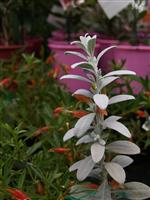 EMU BUSHES
Genus: Eremophila
Common Name: Emu Plant
Family: Myoporaceae
Appearance: Shrubs or ground covers
Flowers: Tubular flowers, often large and colourful.
...(Excerpt from page) Click to read more
EMU BUSHES
Genus: Eremophila
Common Name: Emu Plant
Family: Myoporaceae
Appearance: Shrubs or ground covers
Flowers: Tubular flowers, often large and colourful.
...(Excerpt from page) Click to read more
|
| Euodia
Genus: Euodia
Common Name: Evodia
Family: Rutaceae
Appearance: Shrubs and trees, erect plants, deciduous or evergreen.
Flowers: Large heads of small flowers.
Features: Attractive to nectar feeding birds and animals, many have herbal or other uses (eg. for medicines, cosmetics, timber, ingredient in varnish etc).
...(Excerpt from page) Click to read more
|
Euonymous
 Euonymus
Spindle tree
Family Celastraceae
Around 170 species, many species and hybrids. They make good ornamental plants.
Can be trained as a topiary or hedge; as a tub specimen, or in a bed amongst other shrubs for foliage colour (variegated foliage forms are stunning when contrasted against a backdrop of other foliage colours).
Good against a wall or fence as an espalier or as a full bush if space allows. Suitable for cold gardens, seaside gardens, shady dry gardens.
Slightly tender deciduous and evergreen shrubs, with clusters of small greenish or purplish flowers....(Excerpt from page) Click to read more
Euonymus
Spindle tree
Family Celastraceae
Around 170 species, many species and hybrids. They make good ornamental plants.
Can be trained as a topiary or hedge; as a tub specimen, or in a bed amongst other shrubs for foliage colour (variegated foliage forms are stunning when contrasted against a backdrop of other foliage colours).
Good against a wall or fence as an espalier or as a full bush if space allows. Suitable for cold gardens, seaside gardens, shady dry gardens.
Slightly tender deciduous and evergreen shrubs, with clusters of small greenish or purplish flowers....(Excerpt from page) Click to read more
|
Euphorbia
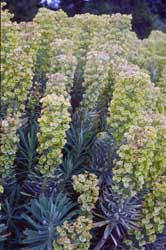 EUPHORBIAS
Genus: Euphorbia
Common Name: Spurge
Family: Euphorbiaceae
Appearance: Variable plants in height, some have a succulent, cactus-like appearance.
Flowers: Insignificant flowers surrounded by colourful bracts usually in autumn-winter.
...(Excerpt from page) Click to read more
EUPHORBIAS
Genus: Euphorbia
Common Name: Spurge
Family: Euphorbiaceae
Appearance: Variable plants in height, some have a succulent, cactus-like appearance.
Flowers: Insignificant flowers surrounded by colourful bracts usually in autumn-winter.
...(Excerpt from page) Click to read more
|
| Feijoa
Genus: Feijoa
Family: Myrtaceae
Appearance: Evergreen shrubs or small trees with downy green leaves with whitish colour beneath. Edible fruit.
Flowers: White and red edible flowers.
Features: Attractive flowers, fruit and foliage - good as a hedging plant.
Requirements: Fertile, moist, but well drained soils. Full sun. Tropical to temperate, adaptable.
...(Excerpt from page) Click to read more
|
Floral Diagrams Floral Formulae
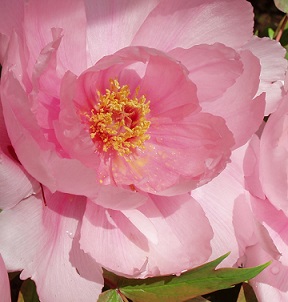 These are ways of representing a flower structure. Both of these are constructed by studying a flower, identifying the various parts (eg. sepals, petals, anthers etc), then representing those components of the flower either graphically or numerically. ...(Excerpt from page) Click to read more These are ways of representing a flower structure. Both of these are constructed by studying a flower, identifying the various parts (eg. sepals, petals, anthers etc), then representing those components of the flower either graphically or numerically. ...(Excerpt from page) Click to read more
|
Frangipani
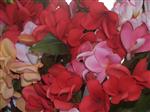 Plumeria
Frangipani
Family Apocynaceae
Approximately 8 species of deciduous to semi-deciduous trees and shrubs.
Leaves are simple, alternate & entire; stems are thick and fleshy; foliage is often scarce except at the ends of the stems.
The flowers, which are often large and colourful emerge at the growing tips.
Grown predominantly in tropical and sub-tropical areas for their showy, fragrant flowers.
It can be used to provide summer shade for nearby plants, while allowing light to penetrate when leaves drop in winter.
...(Excerpt from page) Click to read more
Plumeria
Frangipani
Family Apocynaceae
Approximately 8 species of deciduous to semi-deciduous trees and shrubs.
Leaves are simple, alternate & entire; stems are thick and fleshy; foliage is often scarce except at the ends of the stems.
The flowers, which are often large and colourful emerge at the growing tips.
Grown predominantly in tropical and sub-tropical areas for their showy, fragrant flowers.
It can be used to provide summer shade for nearby plants, while allowing light to penetrate when leaves drop in winter.
...(Excerpt from page) Click to read more
|
Fuchsias
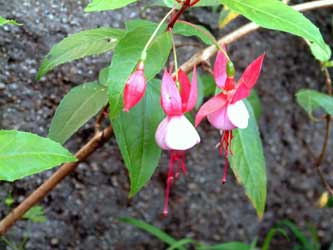 Fuchsia
Family Onagraceae
There are around 100 species, many cultivars and hybrids.
Smaller varieties are readily grown in pots and hanging baskets, as an ornamental shrub, taller varieties can be grown as bushes in garden beds, on embankments,
or as standards - dwarf varieties are occasionally grafted onto taller rootstock.
They grow well under a sparse cover taller shade trees providing protection from extreme weather.
Most are shrubs, but there is also some trees and small trailing plants. ...(Excerpt from page) Click to read more
Fuchsia
Family Onagraceae
There are around 100 species, many cultivars and hybrids.
Smaller varieties are readily grown in pots and hanging baskets, as an ornamental shrub, taller varieties can be grown as bushes in garden beds, on embankments,
or as standards - dwarf varieties are occasionally grafted onto taller rootstock.
They grow well under a sparse cover taller shade trees providing protection from extreme weather.
Most are shrubs, but there is also some trees and small trailing plants. ...(Excerpt from page) Click to read more
|
Gardenias
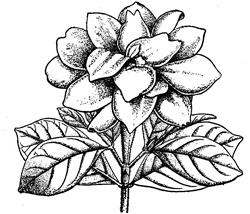 Gardenia
Family Rubiaceae
There are around 200 species, and many named cultivars.
They are good as a scented feature plant amongst other shrubs, as a tub plant; or more specifically as a hedge, or in a mixed with tropical foliage plants to create a tropical effect.
These evergreen shrubs or small trees, have rich green leaves, and white or yellow flowers; usually large and often fragrant.
...(Excerpt from page) Click to read more
Gardenia
Family Rubiaceae
There are around 200 species, and many named cultivars.
They are good as a scented feature plant amongst other shrubs, as a tub plant; or more specifically as a hedge, or in a mixed with tropical foliage plants to create a tropical effect.
These evergreen shrubs or small trees, have rich green leaves, and white or yellow flowers; usually large and often fragrant.
...(Excerpt from page) Click to read more
|
Growing Acalypha Courses, Books, Advice
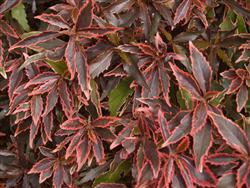 The genus Acalypha (common name Beefsteak plant or Copper leaf) belongs to the family Euphorbiaceae. These are hardy, fast growing, mainly shrubs (occasionally ground covers) with colourful foliage.
Flowers: Insignificant small spikes in summer to autumn, except A. hispida which has attractive red catkins....(Excerpt from page) Click to read more The genus Acalypha (common name Beefsteak plant or Copper leaf) belongs to the family Euphorbiaceae. These are hardy, fast growing, mainly shrubs (occasionally ground covers) with colourful foliage.
Flowers: Insignificant small spikes in summer to autumn, except A. hispida which has attractive red catkins....(Excerpt from page) Click to read more
|
| Growing Figs
The fig (Ficus carica) is a large spreading deciduous tree with very broad leaves. It also has a number of rather unusual features. The flowers are enclosed within a fleshy receptacle which eventually becomes the fruit. The tree likes warm climates and should be protected from frost when young. The mature tree, on the other hand, is astonishingly hardy and may even tolerate as much as 10degrees of frost. The trees also bear two crops of fruit per year....(Excerpt from page) Click to read more
|
| Henna
Genus: Lawsonia
Common Name: Henna
Family: Lythraceae
Appearance: Variable shrubs.
Flowers: Terminal panicles of flowers.
Features: The dried flowers are used as an orange dye (Henna).
...(Excerpt from page) Click to read more
|
Hibiscus
 HIBISCUS
The genus Hibiscus includes many shrubs, some herbs, and trees. Leaves are lobed (palmately) or entire.
The common name is Mallow or Mallow Rose; and the genus comes from the family Malvaceae
Flowers: Mainly solitary, usually bell shaped, 5 petals, distinctive style with anthers attached.
Flowers vary in colour, shape and habit. main flowering period in throughout warmer months however spot flowers at other times do occur.
Features: Hedging plant, flowering specimen, standards, espalier,may be bird attracting.
A good plant to use to give the 'Hawaiian' affect.
Requirements: Fertile and moist, but well drained soil required that is slightly acid to neutral.
Heavy clays subject to water logging are particularly bad for these plants.
Sandy soil ...(Excerpt from page) Click to read more
HIBISCUS
The genus Hibiscus includes many shrubs, some herbs, and trees. Leaves are lobed (palmately) or entire.
The common name is Mallow or Mallow Rose; and the genus comes from the family Malvaceae
Flowers: Mainly solitary, usually bell shaped, 5 petals, distinctive style with anthers attached.
Flowers vary in colour, shape and habit. main flowering period in throughout warmer months however spot flowers at other times do occur.
Features: Hedging plant, flowering specimen, standards, espalier,may be bird attracting.
A good plant to use to give the 'Hawaiian' affect.
Requirements: Fertile and moist, but well drained soil required that is slightly acid to neutral.
Heavy clays subject to water logging are particularly bad for these plants.
Sandy soil ...(Excerpt from page) Click to read more
|
| Holmskioldia
The genus Holmskioldia includes shrubs with spiny, arching branches with flowers either terminal or along branches, from the family Verbenaceae.
Appearance: Flowers: Tubular, resembling a Chinese coolie's hat, generally in spring and autumn.
Features: Well shaped garden plant with attractive flowers (large ornamental calyx).
Requirements: Prefers a moist, fertile soil, but is very adaptable. Prefers tropical or tropical climates.
Sensitive to frosts. Does well in sun and part shade.
...(Excerpt from page) Click to read more
|
| Hydrangeas
Hydrangea
Family Saxifragaceae
Approximately 23 species, and many named cultivars.
Used as a screen plant, or in garden beds, as a tub plant, or for cut flowers.
They are excellent for south and east facing walls (opposite in the northern hemisphere), and good in acid soils and can tolerate clay soils in partial shaded locations.
...(Excerpt from page) Click to read more
|
Hypericum
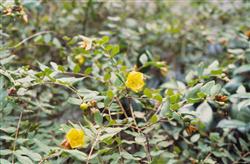 Hypericum
St John's wort
Family Hypericaceae
Approximately 300 or more species (depending on authority); grown as ornamentals amongst other shrubs in a rock garden, as a border to a bed, or occasionally massed to cover the ground in the shade of trees.
Deciduous and evergreen, herbs or shrubs, most are low growing, mainly from temperate parts of northern hemisphere. Cup shaped yellow flowers, occur over long periods.
...(Excerpt from page) Click to read more
Hypericum
St John's wort
Family Hypericaceae
Approximately 300 or more species (depending on authority); grown as ornamentals amongst other shrubs in a rock garden, as a border to a bed, or occasionally massed to cover the ground in the shade of trees.
Deciduous and evergreen, herbs or shrubs, most are low growing, mainly from temperate parts of northern hemisphere. Cup shaped yellow flowers, occur over long periods.
...(Excerpt from page) Click to read more
|
Impatiens
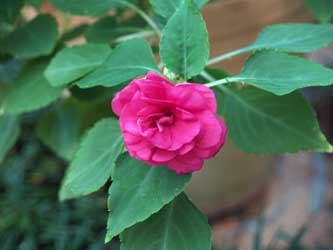 Impatiens are low growing, soft wooded (herbaceous) flowering shrubs, commonly called Balsam or Busy Lizzie. They belong to the family: Balsaminaceae.
One of the most popular plants, grown around the world, as garden shrubs and colourful boarders in the tropics and mild climates, or annual bedding plants or indoor plants in colder climates....(Excerpt from page) Click to read more Impatiens are low growing, soft wooded (herbaceous) flowering shrubs, commonly called Balsam or Busy Lizzie. They belong to the family: Balsaminaceae.
One of the most popular plants, grown around the world, as garden shrubs and colourful boarders in the tropics and mild climates, or annual bedding plants or indoor plants in colder climates....(Excerpt from page) Click to read more
|
Indigofera (Indigo)
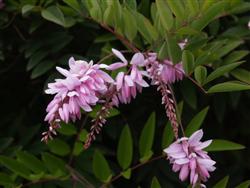 Indigofera include around 750 species of low growing shrubs and herbs with light blue to green pinnate leaves. Commonly called "indigo" these plants belong to the family Fabaceae.
Flowers: Spikes of red, purplish or lavender coloured pea-like flowers.
Features: Some species were formerly grown to produce the dye 'indigo'.
Requirements: Fertile, moist, but well drained soils preferred. Most are adaptable, but prefer warm, protected conditions.
Culture: They generally respond well to plenty of moisture during the warm months. Straggly species generally respond well to regular tip pruning. Propagated by seed or cuttings.
...(Excerpt from page) Click to read more
Indigofera include around 750 species of low growing shrubs and herbs with light blue to green pinnate leaves. Commonly called "indigo" these plants belong to the family Fabaceae.
Flowers: Spikes of red, purplish or lavender coloured pea-like flowers.
Features: Some species were formerly grown to produce the dye 'indigo'.
Requirements: Fertile, moist, but well drained soils preferred. Most are adaptable, but prefer warm, protected conditions.
Culture: They generally respond well to plenty of moisture during the warm months. Straggly species generally respond well to regular tip pruning. Propagated by seed or cuttings.
...(Excerpt from page) Click to read more
|
| Iresine -How to grow Iresine
This genus Iresine includes around 70 low to medium shrubs and herbs with generally small or insignificant flowers. The common name is Blood leaf. It belongs to the family Amaranthaceae.
Features: Grown for their ornamental foliage. Commonly used indoors or as bedding plants.
...(Excerpt from page) Click to read more
|
| Ixora
Ixora include around 400 species from the Rubiaceae family.
Appearance: Shrubs or trees with deep green large leaves when grown in shade and light green if exposed to full sun.
Flowers: Clustered heads of tubular flowers in various colours.
Features: Brilliant flower clusters.
Requirements: Fertile and neutral soil pH preferred. Do not allow soil to dry out. Tropical to warm temperate. Best in part sun.
...(Excerpt from page) Click to read more
|
Jatropha
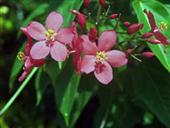 JATROPHA
The genus Jatropha include around 125 species from the Euphorbiaceae family. These are herbs, shrubs and trees; leaking a milky or watery sap when the stem is damaged.
Flowers: Attractive flowers borne conspicuously on the plants.
Requirements: tolerates drier conditions, but does best in fertile soils. Full sun is best.
Culture: Plants tend to thrive with minimum attention. Additional care will improve growth.
...(Excerpt from page) Click to read more
JATROPHA
The genus Jatropha include around 125 species from the Euphorbiaceae family. These are herbs, shrubs and trees; leaking a milky or watery sap when the stem is damaged.
Flowers: Attractive flowers borne conspicuously on the plants.
Requirements: tolerates drier conditions, but does best in fertile soils. Full sun is best.
Culture: Plants tend to thrive with minimum attention. Additional care will improve growth.
...(Excerpt from page) Click to read more
|
| Justacia, Shrimp Plant
The genus Justicia includes approximately 300 species from the family Acanthaceae.
Common Name: Shrimp plants
Appearance: Herb-like small shrubs.
Flowers: Small attractive tubular flowers enclosed in colourful overlapping bracts. Differs only slightly from Pachystachys in that staemens are located at the base of the corolla tube.
Features: Good for hedging and mass display.
Requirements: Keep soil fertile and moist. A neutral pH is preferred. Tropical to warm temperate conditions. Full sun to part shade....(Excerpt from page) Click to read more
|
Lantana
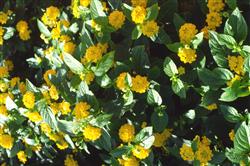 LANTANA
The genus Lantana includes 155 species; which may be weeds or prized ornamental plants, depending upon where you live.
Commonly called "Shrub Verbena" or "Lantana" these plants can be vigorous. They belong to the family Verbenaceae.
Appearance: Shrubs or herbs often prickly, light green leaves, somewhat spreading shape.
Flowers: Small clusters of brightly coloured flowers borne in profusion over warmer months.
Features: Sometimes a weed in subtropic and tropical climates where some types can self sow.
...(Excerpt from page) Click to read more
LANTANA
The genus Lantana includes 155 species; which may be weeds or prized ornamental plants, depending upon where you live.
Commonly called "Shrub Verbena" or "Lantana" these plants can be vigorous. They belong to the family Verbenaceae.
Appearance: Shrubs or herbs often prickly, light green leaves, somewhat spreading shape.
Flowers: Small clusters of brightly coloured flowers borne in profusion over warmer months.
Features: Sometimes a weed in subtropic and tropical climates where some types can self sow.
...(Excerpt from page) Click to read more
|
| Lilac -Syringia
Syringia
Lilac
Family Oleaceae
Around 30 species, and a large number of named cultivars; all deciduous shrubs and small trees.
Large showy panicles of flower are shades of white through pink, red, purple or lilac; and are frequently highly scented.
Lilacs are very hardy in cold climates, and will grow in milder temperate zones. They do not do well in hot or humid climates
They will grow in most soils, provided they do not become very hard, hot or dry.
They do well in full sun or light shade; like their roots mulched, and respond well to occasional watering and feeding.
Prune moderately after flowering to shape and encourage stronger flowering in the next season.
...(Excerpt from page) Click to read more
|
| Lobelia
LOBELIA
The genus Lobelia (Family: Lobeliaceae) includes around 375 species of shrubs, herbs, annuals and perennials, most from temperate climates.
Appearance: Small green foliage somewhat succulent.
Flowers: Highly attractive coloured flower stalks in mainly white, mauves, & reds.
...(Excerpt from page) Click to read more
|
Lonicera; Honeysuckles
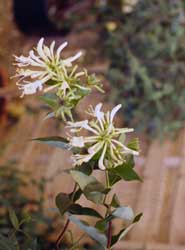 The genus Lonicera (Common Name: Honeysuckle, Family: Caprifoliaceae) includes approximately 150 species.
These are mainly rambling shrubs or climbers with deep green opposite leaves on thin twining branches.
Flowers:
Mainly have small but showy flowers, mostly white with some scent.
Requirements: Prefers moist fertile soils. Adapted to tropics very well. Protect from severe coastal sea breezes. Will grow in sun and shade but prefers more sunlight....(Excerpt from page) Click to read more
The genus Lonicera (Common Name: Honeysuckle, Family: Caprifoliaceae) includes approximately 150 species.
These are mainly rambling shrubs or climbers with deep green opposite leaves on thin twining branches.
Flowers:
Mainly have small but showy flowers, mostly white with some scent.
Requirements: Prefers moist fertile soils. Adapted to tropics very well. Protect from severe coastal sea breezes. Will grow in sun and shade but prefers more sunlight....(Excerpt from page) Click to read more
|
| Mackinlaya
Genus: Mackinlaya
Family: Araliaceae
Appearance: Medium shrub with large palmate leaves with striking berries.
Flowers: Clusters of small green or purple ball flowers develop into dense clusters of blue pea-sized berries.
Features: Foliage and berries.
Requirements: soil needs to be moist but well drained. Provide filtered light and protection for winds and frosts.
...(Excerpt from page) Click to read more
|
Manihot, Cassava
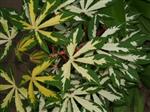 CASAVA
Genus: Manihot
Common Name: Cassava or Tapioca
Family: Euphorbiaceae
Appearance: Shrubs, or herbs with swollen root systems branching at apex of the plant.
Attractive deeply lobed leaves with 5-7 lobes, foliage can be green or variegated.
...(Excerpt from page) Click to read more
CASAVA
Genus: Manihot
Common Name: Cassava or Tapioca
Family: Euphorbiaceae
Appearance: Shrubs, or herbs with swollen root systems branching at apex of the plant.
Attractive deeply lobed leaves with 5-7 lobes, foliage can be green or variegated.
...(Excerpt from page) Click to read more
|
| Melastoma
Genus: Melastoma
Common Name: Lasiandra
Family: Melastomataceae
Appearance: Shrubs and small trees with deep green leaves, usually hairy, with three distinctive veins running through the leaf, fruit is a berry (This distinguishes Melastoma from Tibouchina or true Lasiandra, which has capsule fruits).
Flowers: Terminal spikes of mainly purple, white or pink flowers.
...(Excerpt from page) Click to read more
|
Michelia
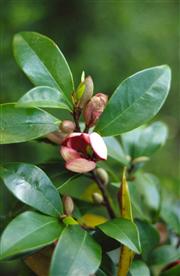 MICHELIA
Genus: Michelia
Family: Magnoliaceae
Appearance: Tall trees and shrubs resembling magnolias.
Flowers: Flowers resemble those of magnolias but are borne in the leaf axils....(Excerpt from page) Click to read more
MICHELIA
Genus: Michelia
Family: Magnoliaceae
Appearance: Tall trees and shrubs resembling magnolias.
Flowers: Flowers resemble those of magnolias but are borne in the leaf axils....(Excerpt from page) Click to read more
|
| Miconia
Genus:
Miconia
Family: Melastomataceae
Appearance: Trees and shrubs with velvet-like leaves. Dark green leaves sometimes with pale veins, undersurface of leaf is purplish. Distinctive veins seen on leaves.
Features: Often gown as an indoor plant. Berries are edible....(Excerpt from page) Click to read more
|
Murraya
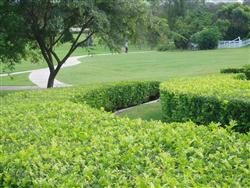 Genus:
Murraya
Common Name: Mock Orange, Orange Jessamine
Family: Rutaceae
Murraya is one of the most widely grown hedge or screening plants in tropical to warm temperate climates.
It has many highly desirable features (rapidly growing, dense foliage, normally few significant health problems).
For many people the strong, sweet scent of Murraya flowers are also a big bonus with this plant; however, for others, this strong perfume can literally cause a headache!...(Excerpt from page) Click to read more
Genus:
Murraya
Common Name: Mock Orange, Orange Jessamine
Family: Rutaceae
Murraya is one of the most widely grown hedge or screening plants in tropical to warm temperate climates.
It has many highly desirable features (rapidly growing, dense foliage, normally few significant health problems).
For many people the strong, sweet scent of Murraya flowers are also a big bonus with this plant; however, for others, this strong perfume can literally cause a headache!...(Excerpt from page) Click to read more
|
Musseanda
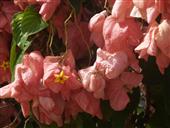 MUSSEANDA
Genus: Mussaenda
Family: Rubiaceae...(Excerpt from page) Click to read more
MUSSEANDA
Genus: Mussaenda
Family: Rubiaceae...(Excerpt from page) Click to read more
|
Myoporum
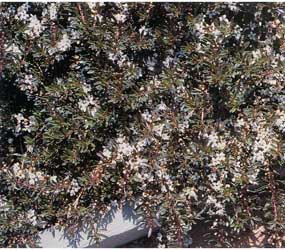 Genus: Myoporum
Common Name: Boobialla
Family: Myoporaceae
Appearance: Mainly shrubs with leaves dotted with glands.
Flowers: Generally small, white flowers.
Features: Some are useful for hedges or windbreaks.
Requirements: Grow in most soils. Many are native to semi arid to arid inland Australia.
Most prefer warm, sunny conditions, but will tolerate very hot and very cold....(Excerpt from page) Click to read more
Genus: Myoporum
Common Name: Boobialla
Family: Myoporaceae
Appearance: Mainly shrubs with leaves dotted with glands.
Flowers: Generally small, white flowers.
Features: Some are useful for hedges or windbreaks.
Requirements: Grow in most soils. Many are native to semi arid to arid inland Australia.
Most prefer warm, sunny conditions, but will tolerate very hot and very cold....(Excerpt from page) Click to read more
|
| Nandina, Sacred Bamboo
Genus: Nandina
Common Name: Sacred Bamboo
Family: Berberidaceae
Appearance: Bamboo-like appearance with many upright, slender, closely packed stems, with attractive foliage (bronze).
Flowers: Small insignificant, white flowers in long panicles.
Features: Attractive bronze-red foliage. Better colour is achieved in cooler areas.
Used as a screen plant or shade plant in warmer areas. Attractive berries. Good tub plant, particularly the dwarf form....(Excerpt from page) Click to read more
|
Oleander; Nerium
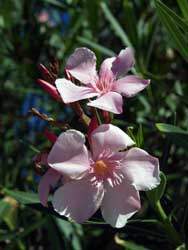 OLEANDER
Genus: Nerium
Common Name: Oleander
Family: Apocynaceae
Appearance: Evergreen erect shrubs.
Flowers: Attractive flowers in terminal, branching clusters. A wide variety of colours available.
Features: All parts of the plant are poisonous. Excellent hedge and windbreak....(Excerpt from page) Click to read more
OLEANDER
Genus: Nerium
Common Name: Oleander
Family: Apocynaceae
Appearance: Evergreen erect shrubs.
Flowers: Attractive flowers in terminal, branching clusters. A wide variety of colours available.
Features: All parts of the plant are poisonous. Excellent hedge and windbreak....(Excerpt from page) Click to read more
|
Ornamental Plants
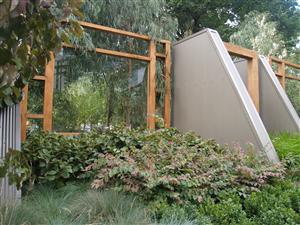 Ornamental Plants are the backbone of garden maintenance, landscaping, parks management and nursery management.
There is a system to the way plants are both classified, and also how they are treated.
If you can learn to identify characteristics which are common to different plant families, you will have a basis upon which to identify any unknown plant.
In a very general sense, plants within the same family also tend to share similar cultural requirements as well; so when you can place a plant in a particular familiy, you can often also determine how to treat it ...(Excerpt from page) Click to read more Ornamental Plants are the backbone of garden maintenance, landscaping, parks management and nursery management.
There is a system to the way plants are both classified, and also how they are treated.
If you can learn to identify characteristics which are common to different plant families, you will have a basis upon which to identify any unknown plant.
In a very general sense, plants within the same family also tend to share similar cultural requirements as well; so when you can place a plant in a particular familiy, you can often also determine how to treat it ...(Excerpt from page) Click to read more
|
| Orthosiphon
Genus: Orthosiphon
Common Name: Cats Whiskers
Family: Lamiaceae
Appearance: Perennial shrub
Flowers: Small flowers with long anthers and stigmas in terminal spikes.
Features: Attractive flowers.
Requirements: Moist fertile, slightly acid soils. Prefers a warm site, with light shade....(Excerpt from page) Click to read more
|
Pelargoniums
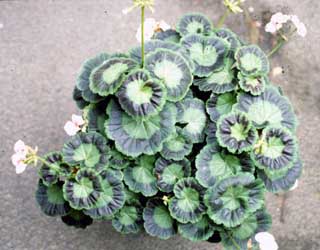 Pelargonium
Geranium or Pelargonium
Family Geraniaceae
About 280 species and thousands of named varieties. Used as container plant, in a garden bed or rockery.
Grown mainly for colourful flowers. These are ideal plants for a paved courtyard area in climates as varied as Hobart, Perth or Sydney.
They do well in Toowoomba, but are more difficult in the humidity of Brisbane.
Herbaceous flowering shrubs; soft foliage and stems often aromatic when crushed, can flower all year in the right situation.
Flower colours are varied but mainly warm colours (red, purple, yellow, orange etc) and white or cream. Usually several colours in the one flower....(Excerpt from page) Click to read more
Pelargonium
Geranium or Pelargonium
Family Geraniaceae
About 280 species and thousands of named varieties. Used as container plant, in a garden bed or rockery.
Grown mainly for colourful flowers. These are ideal plants for a paved courtyard area in climates as varied as Hobart, Perth or Sydney.
They do well in Toowoomba, but are more difficult in the humidity of Brisbane.
Herbaceous flowering shrubs; soft foliage and stems often aromatic when crushed, can flower all year in the right situation.
Flower colours are varied but mainly warm colours (red, purple, yellow, orange etc) and white or cream. Usually several colours in the one flower....(Excerpt from page) Click to read more
|
Pentas
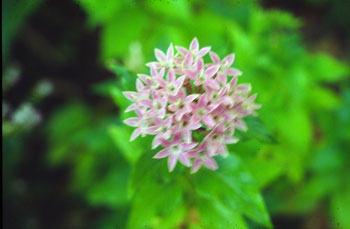 Genus: Pentas
Family: Rubiaceae
Appearance: Shrubs & herbs
Flowers: Some species have separate male & female flowers (appearing different), others have male and female parts in the one flower.
Requirements: Prefers a rich, moist soil. Prefers a warm, semi shaded position.
Culture: Propagate by semi hardwood cuttings. Feed and water regularly. Prune back in winter....(Excerpt from page) Click to read more
Genus: Pentas
Family: Rubiaceae
Appearance: Shrubs & herbs
Flowers: Some species have separate male & female flowers (appearing different), others have male and female parts in the one flower.
Requirements: Prefers a rich, moist soil. Prefers a warm, semi shaded position.
Culture: Propagate by semi hardwood cuttings. Feed and water regularly. Prune back in winter....(Excerpt from page) Click to read more
|
| Phyllanthus
Genus: Phyllanthus
Common Name: Snow Bush
Family: Euphorbiaceae
Appearance: Shrubs, trees & herbs, can be slow growing.
Flowers: Small, petal-less flowers.
Requirements: Prefers fertile, moist, but well drained soil. Prefers full sun to partial shade.
Culture: Water during dry periods, Vigorous root system can block irrigation drippers, Prune regularly to control spread, Propagate by hardwood cuttings or suckers, suckering needs controlling to contain spread.
Pest & Disease: Scale, thrips, aphids, caterpillars, beetles....(Excerpt from page) Click to read more
|
Pittosporum
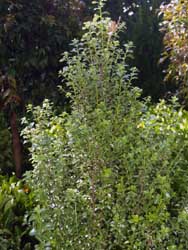 Pittosporum
Family Pittosporaceae
Approximately 150 species and many named cultivars of evergreen trees and shrubs.
They have glossy, undivided leaves. Flowers are sometimes scented, and often colourful.
Fruits are often colourful berries, which make an attractive display, and attract birds.
There are cultivars to suit most temperate and sub tropical climates.
Pittosporums occur naturally in both deserts & rain forests. Some make excellent hedging or screening plant.
Some of the variegated types are widely grown for their foliage....(Excerpt from page) Click to read more
Pittosporum
Family Pittosporaceae
Approximately 150 species and many named cultivars of evergreen trees and shrubs.
They have glossy, undivided leaves. Flowers are sometimes scented, and often colourful.
Fruits are often colourful berries, which make an attractive display, and attract birds.
There are cultivars to suit most temperate and sub tropical climates.
Pittosporums occur naturally in both deserts & rain forests. Some make excellent hedging or screening plant.
Some of the variegated types are widely grown for their foliage....(Excerpt from page) Click to read more
|
| Plant Lists - Growing What Where
PLANTS SUITED TO WET SOIL GARDENS
Extra Hardy (Tolerating full sun, wind & periods of dry to periods of flooding eg: wet summers after dry winters)....(Excerpt from page) Click to read more
|
Rhododendron
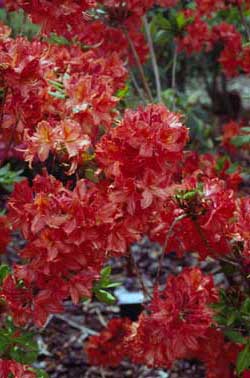 Rhododendron
Family Ericaceae
There are up to 800 species; though most of the cultivated plants are hybrids or cultivars developed from wild species.
There are many thousands of such cultivars being grown; most commonly in garden beds; but sometimes as tub plants or as a screen.
Some smaller varieties have also developed specifically as rockery plants.
Some rhododendrons are simply too large for a small garden; but there are hundreds of others that are ideal for any type of smaller garden....(Excerpt from page) Click to read more
Rhododendron
Family Ericaceae
There are up to 800 species; though most of the cultivated plants are hybrids or cultivars developed from wild species.
There are many thousands of such cultivars being grown; most commonly in garden beds; but sometimes as tub plants or as a screen.
Some smaller varieties have also developed specifically as rockery plants.
Some rhododendrons are simply too large for a small garden; but there are hundreds of others that are ideal for any type of smaller garden....(Excerpt from page) Click to read more
|
Rosa -Roses
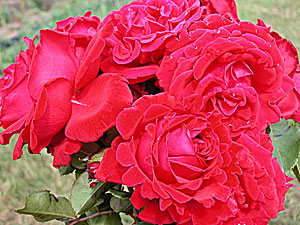 A beautiful bed of roses can be a gardener's pride and joy. Roses are generally very healthy plants and they live a long time if their health is maintained. Always buy healthy plants and choose a full sun site with well drained position to plant them in. As they have a shallow fibrous root system, avoid planting near large trees which have shallow spreading roots....(Excerpt from page) Click to read more A beautiful bed of roses can be a gardener's pride and joy. Roses are generally very healthy plants and they live a long time if their health is maintained. Always buy healthy plants and choose a full sun site with well drained position to plant them in. As they have a shallow fibrous root system, avoid planting near large trees which have shallow spreading roots....(Excerpt from page) Click to read more
|
Roses
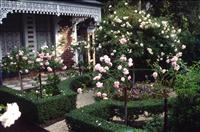 Roses are one of the worlds most popular plants, in home gardens, commercial landscapes, and for cut flower production.
They grow in most parts of the world, but you do need to use the appropriate techniques to match both climate and type of rose grown.
...(Excerpt from page) Click to read more
Roses are one of the worlds most popular plants, in home gardens, commercial landscapes, and for cut flower production.
They grow in most parts of the world, but you do need to use the appropriate techniques to match both climate and type of rose grown.
...(Excerpt from page) Click to read more
|
Taxonomy
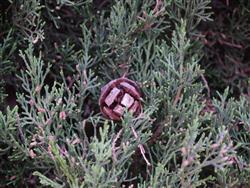 PLANT TAXONOMY (CLASSIFICATION)
Classification and identification of plants is the foundation of good horticulture.
Without accurate identification, we cannot differentiate between the tens of thousands of different plants that we cultivate, and in turn cater to the different cultural requirements of each.
Even at the lowest level of classification there are major differences between what might to the untrained eye appear to be the same plant....(Excerpt from page) Click to read more
PLANT TAXONOMY (CLASSIFICATION)
Classification and identification of plants is the foundation of good horticulture.
Without accurate identification, we cannot differentiate between the tens of thousands of different plants that we cultivate, and in turn cater to the different cultural requirements of each.
Even at the lowest level of classification there are major differences between what might to the untrained eye appear to be the same plant....(Excerpt from page) Click to read more
|
Viburnums
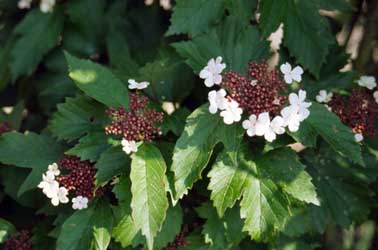 Viburnum
Family Caprifoliaceae
There are approximately 225 species.
Some are used as hedging (eg. V. tinus), screening plant (V. odorattissimum), tub plant, shrubberies.
They tend to grow best in temperate climates but many varieties can grow well in the subtropics.
Many are widely grown for their attractive, often fragrant flowers, and/or attractive berries. Some of the deciduous species also have attractive autumn foliage....(Excerpt from page) Click to read more
Viburnum
Family Caprifoliaceae
There are approximately 225 species.
Some are used as hedging (eg. V. tinus), screening plant (V. odorattissimum), tub plant, shrubberies.
They tend to grow best in temperate climates but many varieties can grow well in the subtropics.
Many are widely grown for their attractive, often fragrant flowers, and/or attractive berries. Some of the deciduous species also have attractive autumn foliage....(Excerpt from page) Click to read more
|
Vireya Rhodos
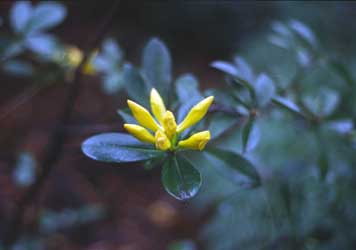 TROPICAL RHODODENDRONS
Some tropical varieties are epiphytic (ie Vireya). Vireyas are cold sensitive types, mostly native to the tropics.
Many will however still grow in colder climates if protected from frost.
Vireya varieties need protection from temperatures above 250C and below 80C.
Foliage us normally glossy green. Most are small to medium shrubs often growing little more than 1-2m tall.
Most epiphytic types prefer a well drained, coarse, organic rich, media.
Propagate cultivars by cuttings....(Excerpt from page) Click to read more
TROPICAL RHODODENDRONS
Some tropical varieties are epiphytic (ie Vireya). Vireyas are cold sensitive types, mostly native to the tropics.
Many will however still grow in colder climates if protected from frost.
Vireya varieties need protection from temperatures above 250C and below 80C.
Foliage us normally glossy green. Most are small to medium shrubs often growing little more than 1-2m tall.
Most epiphytic types prefer a well drained, coarse, organic rich, media.
Propagate cultivars by cuttings....(Excerpt from page) Click to read more
|
Weeds
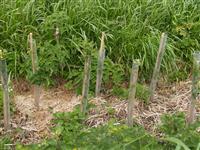 ...(Excerpt from page) Click to read more
...(Excerpt from page) Click to read more
|